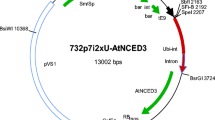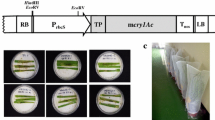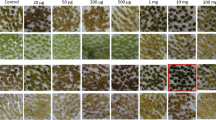Abstract
We have used the bar gene in combination with the herbicide Basta to select transformed rice (Oryza sativa L. cv. Radon) protoplasts for the production of herbicide-resistant rice plants. Protoplasts, obtained from regenerable suspension cultures established from immature embryo callus, were transformed using PEG-mediated DNA uptake. Transformed calli could be selected 2–4 weeks after placing the protoplast-derived calli on medium containing the selective agent, phosphinothricin (PPT), the active component of Basta. Calli resistant to PPT were capable of regenerating plants. Phosphinothricin acetyltransferase (PAT) assays confirmed the expression of the bar gene in plants obtained from PPT-resistant calli. The only exceptions were two plants obtained from the same callus that had multiple copies of the bar gene integrated into their genomes. The transgenic status of the plants was varified by Southern blot analysis. In our system, where the transformation was done via the protoplast method, there were very few escapes. The efficiency of co-transformation with a reporter gene gusA, was 30%. The To plants of Radon were self-fertile. Both the bar and gusA genes were transmitted to progeny as confirmed by Southern analysis. Both genes were expressed in T1 and T2 progenies. Enzyme analyses on T1 progeny plants also showed a gene dose response reflecting their homozygous and heterozygous status. The leaves of To plants and that of the progeny having the bar gene were resistant to application of Basta. Thus, the bar gene has proven to be a useful selectable and screenable marker for the transformation of rice plants and for the production of herbicide-resistant plants.
Similar content being viewed by others
References
Christou P, Ford TL, Kofron M: Production of transgenic rice (Oryza sativa L.) plants from agronomically important indica and japonica varieties via electric discharge particle acceleration of exogenous DNA into immature zygotic embryos. Bio/technology 9: 957–962 (1992).
DeBlock M, Botterman J, Vanderwiele M, Dockx J, Thoen C, Gossele V, Rao Movva N, Thompson C, VanMontagu M, Leemans J: Engineering herbicide resistance in plants by expression of a detoxifying enzyme. EMBO J 6: 2513–2518 (1987).
DeBlock M, DeBrouwer D, Tenning P: Transformation of Brassica napus and Brassica oleracea using Agrobacterium tumefaciens and the expression of the bar and neo genes in the transgenic plants. Plant Physiol 91: 694–701 (1989).
deCarvalho F, Gheysen G, Kushnir S, VanMontagu M, Inze D, Castresana C: Suppression of β-1,3-glucanase transgene expression in homozygous plants. EMBO J 11: 2595–2602 (1992).
DeKeyser R, Claes B, Marichal M, VanMontagu M, Caplan A: Evaluation of selectable markers for rice transformation. Plant Physiol 90: 217–223 (1989).
D'Halluin K, Botterman J, DeGreef W: Engineering of herbicide-resistant alfalfa and evaluation under field conditions. Crop Sci 30: 866–871 (1990).
D'Halluin K, Bossut M, Bonne E, Mazur B, Leemans J, Botterman J: Transformation of sugarbeet (Beta vulgaris L.) and evaluation of herbicide resistance in transgenic plants. Bio/technology 10: 309–314 (1992).
Frearson EM, Power JB, Cocking EC: The isolation, culture and regeneration of Petunia leaf protoplasts. Devel Biol 33: 130–137 (1973).
Fromm ME, Morrish F, Armstrong C, Williams R, Thomas J, Klein TM: Inheritance and expression of chimeric genes in the progeny of transgenic maize plants. Bio/technology 8: 833–839 (1990).
Gordon-Kamm WJ, Spencer TM, Mangano ML, Adams TR, Daines RJ, Start WG, O'Brien JV, Chambers SA, AdamsJr. WR, Willetts NG, Riche TB, Mackey CJ, Krueger RW, Kausch AP, Lemaux PG: Transformation of maize cells and regeneration of fertile transgenic plants. Plant Cell 2: 603–618 (1990).
Goring DR, Thomson L, Rothstein SJ: Transformation of a partial nopaline synthase gene into tobacco suppresses the expression of a resident wild-type gene. Proc Natl Acad Sci USA 88: 1770–1774 (1991).
Hayashimoto A, Li Z, Murai N: A polyethylene glycolmediated protoplast transformation system for production of fertile transgenic rice plants. Plant Physiol 93: 857–863 (1990).
Jefferson RA: Assaying chimeric genes in plants: The GUS gene fusion system. Plant Mol Biol Rep 5: 387–405 (1987).
Kao KN: Chromosomal behaviour in somatic hybrids of soybean-Nicotiana glauca. Mol Gen Genet 150: 225–230 (1977).
Krieg LC, Walker MA, Senratna T, McKersie BD: Growth, ammonia accumulation and glutamine synthetase activity in alfalfa (Medicago sativa L.) shoots and cell cultures treated with phosphinothricin. Plant Cell Rep 9: 80–83 (1990).
Last DI, Gray JC: Synthesis and accumulation of pea plastocyanin in transgenic tobacco plants. Plant Mol Biol 14: 229–238 (1990).
Lee L, Schroll RE, Grimes HD, Hodges TK: Plant regeneration from indica rice (Oryza sativa L.) protoplasts. Planta 178: 325–333 (1989).
Linsmaier EM, Skoog F: Organic growth factor requirements of tobacco tissue culture. Physiol Plant 18: 100–127 (1965).
Matzke MA, Primig M, Trnovsky J, Matzke AJM: Reversible methylation and inactivation of marker genes in sequentially transformed tobacco plants. EMBO J 8: 643–649 (1989).
McCouch SR, Kochert G, Yu ZH, Wang ZY, Khush GS, Coffman WR, Tanksley SD: Molecular mapping of rice chromosomes. Theor Appl Genet 76: 815–829 (1988).
McElroy D, Zhang W, Cao J, Wu R: Isolation of an efficient actin promoter for use in rice transformation. Plant Cell 2: 163–171 (1990).
Murakami T, Anzai H, Imai S, Satoh A, Nagaoka K, Thompson CJ: The bialaphos biosynthetic genes of Streptomyces hygroscopicus: Molecular cloning and characterization of the gene cluster. Mol Gen Genet 205: 42–50 (1986).
Murashige T, Skoog F: A revised medium for rapid growth and bioassays with tobacco tissue cultures. Physiol Plant 15: 473–497 (1962).
Napoli C, Lemieux C, Jorgensen R: Introduction of a chimeric chalcone synthase gene into petunia results in reversible co-suppression of homologous genes in trans. Plant Cell 2: 279–289 (1990).
Peng J, Kononowicz H, Hodges TK: Transgenic indica rice plants. Theor Appl Genet 83: 855–863 (1992).
Potrykus I, Paszkowski J, Saul MW, Petruska J, Shillito RD: Molecular and general genetics of a hybrid foreign gene introduced into tobacco by direct gene transfer. Mol Gen Genet 199: 169–177 (1985).
Saito K, Yamazaki M, Anzai H, Yoneyama K, Murakoshi I: Transgenic herbicide-resistant Atropa belladonna using an Ri binary vector and inheritance of the transgenic trait. Plant Cell Rep 11: 219–224 (1992).
Sambrook J, Fritsch EF, Maniatis T: Molecular Cloning: A Laboratory Manual. Cold Spring Harbor Laboratory Press, Cold Spring Harbor, NY (1989).
Shimamoto K, Terada R, Izawa T, Fujimoto H: Fertile transgenic rice plants regenerated from transformed protoplasts. Nature 338: 274–276 (1989).
Smith CJS, Watson CF, Bird CR, Ray J, Schuch W, Grierson D: Expression of a truncated tomato polygalacturonase gene inhibits expression of the endogenous gene in transgenic plants. Mol Gen Genet 224: 477–481 (1990).
Su RC, Rudert M, Hodges TK: Regeneration of fertile indica and japonica rice (Oryza sativa L.) plants from protoplasts isolated from embryogenic haploid suspension cultures. Plant Cell Rep 12: 45–49 (1992).
Tachibana K, Watanabe T, Sekizawa T, Takemutsu T: Action mechanism of bialaphos. II. Accumulation of ammonia in plants treated with bialaphos. J Pest Sci 11: 33–37 (1986).
Thompson CJ, Movva NR, Tizard R, Crameri R, Davies JE, Lauwereys M, Botterman J: Characterization of the herbicide-resistance gene bar from Streptomyces hygroscopicus. EMBO J 6: 2519–2523 (1987).
Toriyama K, Arimoto Y, Uchimiya H, Hinata K: Transgenic rice plants after direct gene transfer into protoplasts. Bio/technology 6: 1072–1074 (1988).
van derKrol AR, Mur LA, Beld M, Mol JNM, Stuitje AR: Flavonoid genes in petunia: addition of a limited number of gene copies may lead to suppression of gene expression. Plant Cell 2: 291–299 (1990).
Vasil V, Castillo AM, Fromm ME, Vasil IK: Herbicide resistant fertile transgenic wheat plants obtained by microprojectile bombardment of regenerable embryogenic callus. Bio/technology 10: 667–674 (1992).
Wen F, Peng J, Lister RM, Hodges TK: A procedure for regenerating japonica and indica varieties of rice from protoplasts. Plant Mol Biol Rep 9: 308–321 (1991).
White J, Chang S-YP, Bibb MJ: A cassette containing the bar gene of Streptomyces hygroscopicus: a selectable marker for plant transformation. Nucl Acids Res 18: 1062 (1990).
Zhang W, Wu R: Efficient regeneration of transgenic plants from rice protoplasts and correctly regulated expression of the foreign gene in the plants. Theor Appl Genet 76: 835–840 (1988).
Author information
Authors and Affiliations
Rights and permissions
About this article
Cite this article
Rathore, K.S., Chowdhury, V.K. & Hodges, T.K. Use of bar as a selectable marker gene and for the production of herbicide-resistant rice plants from protoplasts. Plant Mol Biol 21, 871–884 (1993). https://doi.org/10.1007/BF00027118
Received:
Accepted:
Issue Date:
DOI: https://doi.org/10.1007/BF00027118




